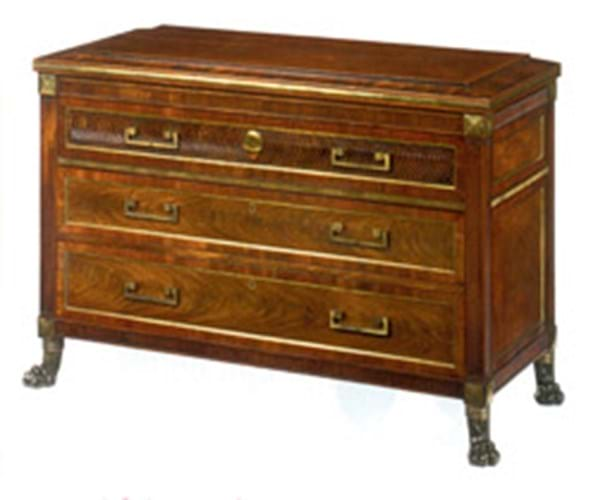
The eleventh-hour withdrawals follow two articles alleging that London dealer John Hobbs had sold as genuine antiques, furniture that was largely the creation of his restorer Dennis Buggins. The dealer - who has denied any wrongdoing or ever having knowingly sold a fake - recently resigned from the British Antique Dealers' Association who had suspended his membership pending an investigation.
Lot 106 in Sotheby's New York sale of June 3 titled Important French Furniture & Decorations, European Ceramics and Carpets was catalogued as "a fine pair of German neoclassical ormolu-mounted mahogany commodes c.1800". They had represented something of a puzzle to Sotheby's specialists. A catalogue footnote speculated that the commodes, estimated at $200,000-300,000, might have been made in Berlin for the Russian market by a cabinetmaker trained in one of the great London workshops.
However, in a claim made to The Sunday Times dated June 1, Mr Buggins, who has turned 'whistleblower' following a bitter financial dispute with his former employer, said he had made them between 1993 and 1994 for John Hobbs from old wardrobes and cedar from a timber merchant. He provided a detailed worksheet to support his claims. ATG had received an anonymous tip-off last month also suggesting the commodes were Hobbs-Buggins creations.
When contacted by The Sunday Times, Sotheby's chose to withdraw the lot from the sale. Alistair Clarke, the worldwide head of English and Continental furniture at Sotheby's, told them: "They are convincingly made and with an intention to deceive. They incorporate elements that appeared to be period. I am now sceptical about them and they have been withdrawn pending further investigation." It is a view that ATG have since confirmed with Sotheby's.
What evidently began as a financial dispute between a dealer and his restorer now threatens to undermine confidence in the antiques trade as a whole.
The fallout from the Buggins-Hobbs allegations was the subject of a 2600-word article in The New York Times co-authored by the writer of The Sunday Times piece, dated May 22, in which a number of prominent interior decorators - all clients of Mr Hobbs - voiced their concerns about the allegations.
In the article Mr Buggins, who says he was unaware that his workshop creations were being offered for sale as genuine, claimed that since 1992 his firm handled in the region of 1875 items for John Hobbs' shop in Dove Walk off Pimlico Road. He says he is considering setting up a website to make available surviving records of every substantially altered or fabricated item that passed through his workshop over the past 20 years. These records do not just include work completed for Mr Hobbs.
The New York Times also published evidence confirming a longstanding business relationship between Mr Buggins and Carlton Hobbs, the New York dealer and estranged brother and former business partner of John Hobbs.
Making reference to "concerns recently expressed in the London antiques community about reproductions and replicas of historical pieces alleged to have been misrepresented as authentic period artefacts", Carlton Hobbs announced in a press release dated May 7 that the company will offer an independent and accredited expert assessment, at no cost to their clients, of any item purchased from the firm in the last 15 years. Should any item be found to have an issue of authenticity or degree of restoration, it will become eligible for Carlton Hobbs's longstanding policy for a full buy-back.
The dealership say analysis of approximately 2100 objects sold over the past 15 years suggests only one per cent merit further review and the purchasers are being notified directly.
They also announced that henceforth each piece of Carlton Hobbs furniture will be sold together with its provenance and "a comprehensive narrative of any work performed on the specific object".
However, despite these assurances, five lots of furniture acquired from the dealership in the 1990s, scheduled to sell in Christie's King Street sale of Four British Collections including Important Furniture on June 5, were pulled from sale. They included a kingwood, simulated kingwood and parcel gilt centre table in the manner of Marsh and Tatham after Henry Holland (estimate £20,000-30,000) and an amboyna, mahogany and satinwood sofa table in the manner of George Smith.
Christie's declined to comment on the withdrawals.
By Roland Arkell




